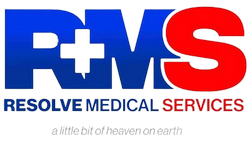Introduction
Time is one of the most valuable resources in a health facility. Whether you run a family clinic in Accra like Resolve Medical Services or manage a large hospital, time determines how many patients are served, how accurate diagnoses are, and ultimately, how lives are saved. However, due to the dynamic and often unpredictable nature of healthcare settings, managing time effectively remains a persistent challenge.
This article explores practical and sustainable strategies for effective time management in health facilities. We’ll address common time-wasting issues in clinical environments and provide realistic solutions tailored for healthcare professionals, administrators, and supporting staff. Special attention will be given to the context of developing countries like Ghana, where staffing and infrastructure challenges are often prevalent.
Why Time Management Is Critical in Healthcare
Effective time management in a health facility influences:
-
Patient Outcomes: Timely interventions can prevent complications or even save lives.
-
Staff Well-being: Proper scheduling reduces burnout and enhances job satisfaction.
-
Operational Efficiency: Reduces patient wait times, increases service delivery, and optimizes resource use.
-
Financial Performance: Better time management can reduce waste and improve profitability.
-
Patient Satisfaction: Clinics that run on time and respect appointments tend to have higher patient trust and loyalty.
Common Time Management Challenges in Health Facilities
Before discussing strategies, it’s important to understand the common time-wasters in healthcare settings:
-
Overbooking or Underbooking Appointments
-
Inefficient Workflows and Paperwork
-
Poor Communication Among Staff
-
Long Patient Wait Times
-
Uncoordinated Shift Planning
-
Limited Use of Technology
-
Interruptions and Emergencies
-
Lack of Delegation or Teamwork
-
Burnout and Fatigue
All of these are exacerbated in resource-limited settings, making strategic time management not a luxury but a necessity.
Strategy 1: Structured Appointment Scheduling
One of the most effective ways to manage time in a health facility is through structured appointment systems. In many local clinics across Ghana, walk-in systems dominate, which often leads to long patient queues and overwhelmed staff.
Implement:
-
Time-block Scheduling: Allocate specific blocks of time for different types of visits—checkups, follow-ups, chronic care, etc.
-
Buffer Time: Add a 10–15-minute buffer between appointments to handle unexpected delays.
-
Limit Walk-ins: While emergencies must always be accommodated, encouraging patients to book ahead improves predictability.
Tools to Use:
-
Simple apps like Google Calendar
-
Clinic management systems (e.g., AfyaPro, OpenMRS)
Strategy 2: Use of Technology to Streamline Operations
Technology can significantly cut down time spent on repetitive or manual tasks. Even basic tools can create noticeable differences in workflow efficiency.
Examples:
-
Electronic Medical Records (EMRs): Reduces time spent retrieving and updating paper files.
-
Digital Triage Systems: Prioritize patients based on urgency and nature of complaint.
-
Telemedicine: Reduce in-clinic visits for consultations that can be done virtually.
-
Inventory Management Software: Tracks stock in real-time and prevents delays caused by stockouts.
In the Ghanaian Context:
Though access to high-end systems may be limited, free or low-cost tools like Microsoft Excel for stock tracking, WhatsApp for patient reminders, or SMS-based appointment alerts can work effectively.
Strategy 3: Task Delegation and Team Roles
Medical professionals often take on too many tasks themselves—from triage to record-keeping—leading to wasted time and burnout.
Best Practices:
-
Clearly Defined Roles: Nurses, administrative staff, and doctors should each have non-overlapping responsibilities.
-
Empower Front Desk Staff: Train them to manage appointments, handle complaints, and triage minor issues before escalation.
-
Use of Volunteers or Interns: Especially during peak seasons, bring in trained volunteers to assist in administrative or community health outreach roles.
Strategy 4: Shift Management and Workforce Planning
Poor shift planning results in overworked staff during peak hours and underutilized staff during downtime. This leads to inefficiencies and fatigue.
Recommendations:
-
Predict Patient Flow: Use historical data to understand which days and hours are busiest.
-
Stagger Shifts: Not all staff need to arrive or leave at the same time. Consider half-day or rotating shifts.
-
Cross-Training: Train staff to perform multiple roles. For example, a nurse who can handle both triage and basic admin work becomes a versatile asset.
Strategy 5: Develop Standard Operating Procedures (SOPs)
Every facility must have clearly documented procedures for common tasks to reduce redundancy and confusion.
SOPs Can Include:
-
Patient intake and triage
-
Documentation of vital signs
-
Handling medical emergencies
-
Discharging patients and follow-up
Having SOPs allows new and existing staff to follow a standard protocol, reducing time wasted in improvisation or miscommunication.
Strategy 6: Daily Briefings and Handover Meetings
Communication breakdown is one of the biggest culprits of time wastage in clinics and hospitals.
Implement:
-
Morning Briefings: 10-minute team huddles to review the day’s schedule, highlight special cases, and share important updates.
-
End-of-Shift Handover: Staff transitioning out must document or verbally communicate patient statuses and pending tasks to the next team.
This improves continuity of care and prevents duplication of work.
Strategy 7: Triage and Patient Flow Optimization
A properly designed patient flow system minimizes idle time and confusion.
Tips:
-
Triage Immediately: As patients arrive, assess urgency and redirect accordingly.
-
Zone the Facility: Create distinct areas for waiting, consultation, treatment, and pharmacy pickup to streamline movement.
-
Signage and Direction: Use signs and arrows so patients don’t waste time trying to find departments.
For Resolve Medical Services, this could mean separating maternity or women’s health services from general OPD (Outpatient Department) areas for smoother flow.
Strategy 8: Regular Time Audits
You can’t manage what you don’t measure.
Conduct:
-
Time-Tracking Studies: Observe how long common procedures take.
-
Feedback from Staff: Let staff report bottlenecks or delays.
-
Patient Surveys: Ask about their waiting times and service experience.
This data can guide decisions on staffing, scheduling, and technology upgrades.
Strategy 9: Create a Culture of Time Awareness
Time management isn’t only about systems—it’s also about mindset.
Build Culture By:
-
Leading by example (management arrives on time)
-
Rewarding punctuality and efficiency
-
Posting reminders like: “Respecting time = Respecting life”
-
Training staff in personal time management and productivity
Strategy 10: Managing Interruptions and Emergencies
Emergencies are inevitable in healthcare. However, not every interruption is critical.
Tips:
-
Use Signaling Tools: For example, doctors can use desk flags to signal “busy” or “available” mode.
-
Emergency Protocols: Have a predefined plan for handling urgent cases without derailing the entire schedule.
-
Designate Emergency Teams: Not every staff member needs to respond to every emergency. Assign rotating emergency response roles.
Bonus: Time Management Tips for Individual Healthcare Workers
Sometimes, the issue lies not in the system, but in personal habits.
Tips for Individual Staff:
-
Plan your day the night before
-
Prioritize tasks using the Eisenhower Matrix (Urgent vs. Important)
-
Avoid multitasking—complete one task at a time
-
Set boundaries for non-essential interruptions
-
Take short, regular breaks to maintain focus
Conclusion
Time is a non-renewable resource in healthcare—and how it is managed can make all the difference in quality of care and operational efficiency. By combining structured systems, smart tools, and a culture of accountability, health facilities like Resolve Medical Services can drastically improve service delivery and patient outcomes.
Effective time management is not just about seeing more patients in less time—it’s about creating a healthier, more sustainable, and more patient-centered system for everyone involved.






Comments are closed